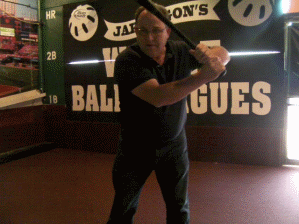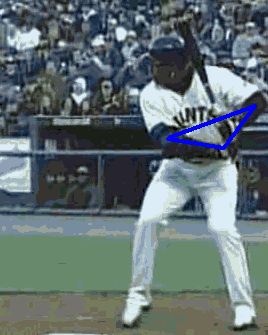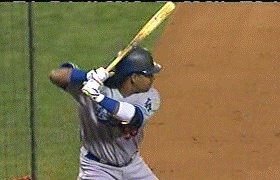
There are three elements of a high level swing. The First Engine. The Second Engine. And the syncage between the two engines.
The First engine is the lower body. The lower gear. Most call it the hips, but the hips in a high level swing are part of the upper body. They are part of the 'fused torso'. A high level swing has an upper body (torso and hips) that is fused into a unit and that unit is pivoted by the rear leg at launch after the StretchNFire type load is created.
But, this article is about the Second Engine itself. It is about the top gear shown above. The Second Engine has three elements to it. First, the Lateral Tilt of the torso. The second is the Triangle Turn (triangle formed by the forearms and chest). Third is the Forearm Rotation. This clip shows the Second Engine and it's three elements.

The above demo is from a tipped barrel but the tip is not a requirement. It can be done from all handsets.
And a key to the movement is it has to be one move not three separate moves. And you do that by making sure all three moves are concentric....or....in parallel planes.
LATERAL TILT:
After a hitter coils his torso usually counter rotates a bit. Some barely. Others quite a bit. Both can be effective if you are working your Second Engine properly. If you care to discuss this feel free to message me. In either case, a little or a lot, the lateral tilt of the torso is SEEN as the lead shoulder working up and the rear shoulder working down. It is actually your fused torso working tilting over the back of the ball of your femur. It is done at the angle you are at after your coil. So, if you're a righty, and you coil, your shoulder line will be pointed toward the 2Bman to some degree. That is the line of your lateral tilt. You laterally tilt so as to maintain that direction as long as you can. That movement is done aggressively....all in. That is one of the most explosive things the body can do. It is an integral part of the launch.
TRIANGLE TURN:
The triangle is the relationship of your forearms to your chest.
Here is a great view of it.

The lead elbow works up. The rear elbow works down. At first Bonds triangle was pointed downward. Sun light rays would pass through it. At the end, he can almost look through it. It has been turned.
FOREARM ROTATION:
Forearm rotation is both supination of the rear forearm and pronation of the lead forearm. And this is an extremely important element. And many miss it. The forearms is where swing QUICKNESS comes from. It is THE SOURCE of swing quickness. The other elements of the Second Engine support....provide a platform....for the forearms to work.
SYNCING UP:
As mentioned above these three actions must turn in concentric or parallel planes. If they do, all three actions work on the barrel TOGETHER...directly....and that produces the body's maximum acceleration ability. IF one of the elements is working out of parallel then you have a wobble going on and your Second Engine is not work efficiently. Your barrel will drag and it will lose accuracy.
Another extremely critical point is the relationship of your rear elbow to the hands and chest. The angle of your rear forearm to your rear upper arm must be within a certain parameter. It must be somewhere between 90 degrees and 60 degrees (give or take....it's personal) It can't be more than 90. You are asking for trouble when it gets less than 60. Experiment with it. None of these numbers are given as hard fast numbers. They are given as a guideline. You'll be able to find YOUR spot when you execute the following. Establish the handset as just mentioned, then draw a visual line from your hands to your chest while in your handset. Another visual line, from your rear elbow forward will bisect that handtochest line. That line is critical. You must turn your Second Engine so that the elbow moves, is turned, forward ON THAT LINE extended. This is the power line. Generally speaking that line is parallel to your chest AT LAUNCH. However, the leg is going to turn the chest. YOU MUST MAINTAIN THAT LINE TO THE BEST OF YOUR ABILITY. You must swing 'out from' your body and not 'around' your body. Here is Manny swinging out from his body....

His chest is being turned as the leg turns the torso. But his elbow stays on the power line for as long as possible. This is not disconnection. It would be disconnection if you had a spinal rotation swing. But high level hitters have a forearm axis. Manny is keeping his forearm axis turned barrel....on the line of the pitch....and not allowing his body to pull him off the ball.
This line must be maintained by the launch so that the energy developed from your lower gear reaches the barrel. I will fully acknowledge that a hitter might have to 'let out' a bit to get to an outside pitch. Or, 'pull in' a bit to get to an inside pitch. That's fine. But the launch itself must be done so that the elbow travels down that line initially.
The actions that create what I've described are quite simple.
Lateral tilt of the torso.
Adduction of the rear elbow.
Abduction of the lead elbow.
Supination of the rear forearm.
Pronation of the lead forearm.
You must avoid external rotation of the humerus.
